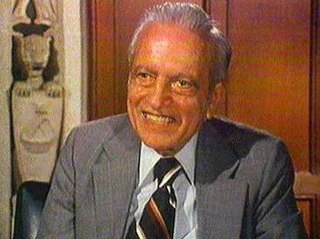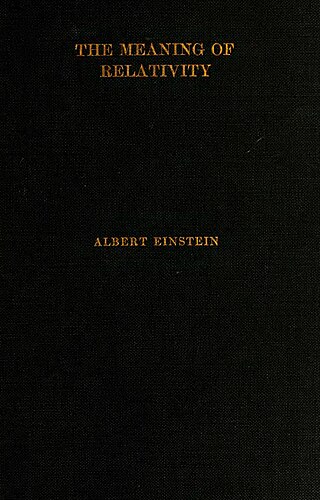Related Research Articles
Terrell rotation or the Terrell effect is the visual distortion that a passing object would appear to undergo, according to the special theory of relativity, if it were travelling at a significant fraction of the speed of light. This behaviour was described independently by both Roger Penrose and James Edward Terrell. Penrose's article was submitted 29 July 1958 and published in January 1959. Terrell's article was submitted 22 June 1959 and published 15 November 1959. The general phenomenon was noted already in 1924 by Austrian physicist Anton Lampa.

Banesh Hoffmann was a British mathematician and physicist known for his association with Albert Einstein.
The Mechanical Universe...And Beyond is a 52-part telecourse, filmed at the California Institute of Technology, that introduces university level physics, covering topics from Copernicus to quantum mechanics. The 1985-86 series was produced by Caltech and INTELECOM, a nonprofit consortium of California community colleges now known as Intelecom Learning, with financial support from Annenberg/CPB. The series, which aired on PBS affiliate stations before being distributed on LaserDisc and eventually YouTube, is known for its use of computer animation.

Wolfgang Rindler was an Austrian physicist working in the field of general relativity where he is known for introducing the term "event horizon", Rindler coordinates, and for the use of spinors in general relativity. An honorary member of the Austrian Academy of Sciences and foreign member of the Accademia delle Scienze di Torino, he was also a prolific textbook author.

Robert M. Wald is an American theoretical physicist and professor at the University of Chicago. He studies general relativity, black holes, and quantum gravity and has written textbooks on these subjects.
Francis Weston Sears was an American physicist. He was a professor of physics at MIT for 35 years before moving to Dartmouth College in 1956. At Dartmouth, Sears was the Appleton Professor of Physics. He is best known for co-authoring University Physics, an introductory physics textbook, with Mark Zemansky. The book, first published in 1949, is often referred to as "Sears and Zemansky", although Hugh Young became a coauthor in 1973.

General Relativity is a graduate textbook and reference on Albert Einstein's general theory of relativity written by the gravitational physicist Robert Wald.

Nathaniel David Mermin is a solid-state physicist at Cornell University best known for the eponymous Hohenberg–Mermin–Wagner theorem, his application of the term "boojum" to superfluidity, his textbook with Neil Ashcroft on solid-state physics, and for contributions to the foundations of quantum mechanics and quantum information science.

Fundamentals of Physics is a calculus-based physics textbook by David Halliday, Robert Resnick, and Jearl Walker. The textbook is currently in its 12th edition.
Robert Geroch is an American theoretical physicist and professor at the University of Chicago. He has worked prominently on general relativity and mathematical physics and has promoted the use of category theory in mathematics and physics. He was the Ph.D. supervisor for Abhay Ashtekar, Basilis Xanthopoulos and Gary Horowitz. He also proved an important theorem in spin geometry.
Edwin Floriman Taylor is an American physicist known for his contributions to the teaching of physics. Taylor was editor of the American Journal of Physics, and is author of several introductory books to physics. In 1998 he was awarded the Oersted Medal for his contributions to the teaching of physics.

The Feynman Lectures on Physics is a physics textbook based on a great number of lectures by Richard Feynman, a Nobel laureate who has sometimes been called "The Great Explainer". The lectures were presented before undergraduate students at the California Institute of Technology (Caltech), during 1961–1964. The book's co-authors are Feynman, Robert B. Leighton, and Matthew Sands.

Classical Electrodynamics is a textbook written by theoretical particle and nuclear physicist John David Jackson. The book originated as lecture notes that Jackson prepared for teaching graduate-level electromagnetism first at McGill University and then at the University of Illinois at Urbana-Champaign. Intended for graduate students, and often known as Jackson for short, it has been a standard reference on its subject since its first publication in 1962.
Eugene Hecht is an American physicist and author of a standard work in optics.

Electricity and Magnetism is a standard textbook in electromagnetism originally written by Nobel laureate Edward Mills Purcell in 1963. Along with David Griffiths' Introduction to Electrodynamics, this book is one of the most widely adopted undergraduate textbooks in electromagnetism. A Sputnik-era project funded by the National Science Foundation grant, the book is influential for its use of relativity in the presentation of the subject at the undergraduate level. In 1999, it was noted by Norman Foster Ramsey Jr. that the book was widely adopted and has many foreign translations.

The Meaning of Relativity: Four Lectures Delivered at Princeton University, May 1921 is a book published by Princeton University Press in 1922 that compiled the 1921 Stafford Little Lectures at Princeton University, given by Albert Einstein. The lectures were translated into English by Edwin Plimpton Adams. The lectures and the subsequent book were Einstein's last attempt to provide a comprehensive overview of his theory of relativity and is his only book that provides an accessible overview of the physics and mathematics of general relativity. Einstein explained his goal in the preface of the book's German edition by stating he "wanted to summarize the principal thoughts and mathematical methods of relativity theory" and that his "principal aim was to let the fundamentals in the entire train of thought of the theory emerge clearly". Among other reviews, the lectures were the subject of the 2017 book The Formative Years of Relativity: The History and Meaning of Einstein's Princeton Lectures by Hanoch Gutfreund and Jürgen Renn.

Lectures on Theoretical Physics is a six-volume series of physics textbooks translated from Arnold Sommerfeld's classic German texts Vorlesungen über Theoretische Physik. The series includes the volumes Mechanics, Mechanics of Deformable Bodies, Electrodynamics, Optics, Thermodynamics and Statistical Mechanics, and Partial Differential Equations in Physics. Focusing on one subject each semester, the lectures formed a three-year cycle of courses that Sommerfeld repeatedly taught at the University of Munich for over thirty years. Sommerfeld's lectures were famous and he was held to be one of the greatest physics lecturers of his time.
Six Ideas that Shaped Physics is a textbook in calculus based physics, written by Thomas A. Moore based on his introductory course in college physics at Pomona College. It covers special relativity, quantum mechanics, and thermodynamics. The impetus for the project to author the book came from the 1987-1996 Introductory University Physics Project (IUPP), which found that most college texts neglected to teach topics in 20th century physics.
References
- ↑ "Thomas A. Moore". Pomona College. Retrieved June 20, 2024.
- ↑ Thomsen, Marilyn (May 22, 2024). "Faculty in Biology, History and Physics Named to Endowed Professorships". Pomona College . Retrieved June 20, 2024.
- ↑ Joseph Amato (1996). "The Introductory Calculus-Based Physics Textbook". Physics Today . 49 (12): 46–51. doi:10.1063/1.881581.
- ↑ 李广平, 张立彬 (March 20, 2012). "决定物理学发展的六大思想" [Six Ideas That Shaped Physics]. 大学物理[College Physics] (in Chinese). 31 (3): 55. ISSN 1000-0712.
- ↑ Bernatowicz, Thomas J. (March 1, 2006). "Post-Use Review. Six Ideas That Shaped Physics (second edition, six volumes)." American Journal of Physics . 74 (3): 243–245. doi:10.1119/1.2149873. ISSN 0002-9505.
- ↑ Whitten, Barbara L.; Burciaga, Juan R. (2000). "Feminist and Multicultural Pedagogy in Physics: A Status Report". Women's Studies Quarterly . 28 (1/2): 213–235. JSTOR 40004456.
- ↑ Baumgarte, Thomas W. (2013). "Review of A General Relativity Workbook". American Journal of Physics . 81: 317–318. doi:10.1119/1.4789548.
- ↑ Sarbach, Olivier (2014). "Review of A General Relativity Workbook". Physics Today . 67 (5): 54–55. doi:10.1063/PT.3.2387.